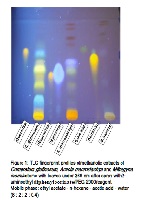Identification and quantification of phenolic compounds and flavonoids in anthelmintic ethnoveterinary plants used among Fulani and Mosse, Central Burkina Faso
Keywords:
herbalanthelminthics, polyphenols, quercetin, Acacia macrostachya, Combretumglutinosum, MitragynainermisAbstract
Helminthic diseases are the leading cause of loss of animals in the Sahel region of Western Africa. Poverty, combined with the poor development of modern veterinary services, forces small farmers to use herbals to treat their livestock. A previous ethnoveterinary survey, carried out in the region of Saba in Burkina Faso, indicates a frequent use of the leaves ofAcaciamacrostachyaDC.(Leguminosae), CombretumglutinosumPerr.ex DC. (Combretaceae) and Mitragynainermis (Willd.)Kuntze to treat helminthic diseases. Phytochemical screening has allowed us to characterize sterols, triterpens, flavonoids and tannins as the main phytochemical classesof these 3 species; phenolic compounds range from 2.5 to 8 % and a series of bioactive polyphenols (quercetin, rutin, gallic acid) have been identified by thin-layer chromatography. The obtained results indicate the richness of these herbs in phenolic compounds. The biological activity, toxicology and phytochemistry of the 3 species warrant further investigation to justify their ethnoveterinary uses.
References
. INSD (Institut National de Statistiques et
de la Démographie), Rapport de
l'enquête annuelle sur les conditions de
vie des ménages et le suivi de la
pauvreté, Ministère de lÊéconomie et des
finances du Burkina Faso,
Ouagadougou, 2007.
. Ouatarra 0. Etude de lÊactivité
pharmacologique des amandes de
Balanites aegyptiaca (L) Del
(Balanitaceae), Propriétés
anthelminthiques et molluscicides.
Thesis, Faculty of Pharmacy, Université
de Ouagadougou, Ouagadougou,
Burkina Faso;2000.
. Mckellar QA, Jackson F. Veterinary
anthelmintics: old and new. Trends in
Parasitol.2001;20 (10): 456-461.
. Waller PJ, Thamsborg SM. Nematode
control in ÂgreenÊ ruminant production
systems. Trends in Parasitol.2004; 20
(10): 493-497
. Geary TG, ConderandGA, Bishop B. The
changing landscape of antiparasitic drug
discovery for veterinary medicine.
Trends in Parasitol. 2004; 20 (10): 449-
. Abebe D, Ayehu A. Medicinal plants and
health practices of Northern Ethiopia.
B.S.P.E, Addis Ababa ;1993
. Mathias E, McCorkle M, Van Veen TWC.
Introduction to ethnoveterinary research
and development.In Ethnoveterinary
research and development. McCorkle
CM, Mathias E, Schillhorn van Veen
TW, (Eds): Intermediate Technology
Publications, London; 1996.
. Ake-Assi L, Abeye J, Guinko S, Giguet R,
Bangavou Y.Contribution à
lÊidentification et au recensement des
plantes utilisées dans la médecine
traditionnelle et la pharmacopée en
Empire Centrafricain. Agence de
Coopération Culturelle et Technique,
Paris ; 1978,
. Von Maydell HJ. Trees and Shrubs of the
Sahel, their characteristics and uses.
Edited by GTZ: Verlag Josef Margraf,
Weikersheim (Germany);1990.
. Neuwinger HD. African Traditional
Medecine, a dictionnary of plant use
andapplications. Medpharm,
Suttgart:2000
. Nacoulma-Ouedraogo OG. Plantes
médicinales et pratiques médicales
traditionnelles au Burkina Faso. Thesis,
Faculty of Sciences and Techniques,
Université de Ouagadougou,
Ouagadougou, Burkina Faso ;1996.
. Singleton VL, Orthofer R, LamuelaRaventós, RM. Analysis of total phenols
and other oxidation substrates and
antioxidants by means of folin-ciocalteu
reagent. In P. Lester (Ed.),
Meth.Enzymol. 1999; 299: 152-178.
. Arvouet-Grand A, Vennat B, Pourrat A,
Legret P. Standardisation d`un extrait de
propolis et identification des principaux
constituants. J. Pharm. Belg.1994 ; 49:
-468.
. Asase A, Kokubun T, Grayer RJ, Kite G,
Simmonds MSJ, Yeboah AAO,
Odamtten GT. Chemical constituents
and antimicrobial activity of medicinal
plants from Ghana: Cassia sieberiana,
Haematostaphis barteri, Mitragyna
inermis and Pseudocedrela kotschyi.
Phytother.Res.2008; 22: 1013-1016.
. Fiot J, Baghdikian B, Boyer L, Mahiou V,
Azas N, Gasquet M, Timon-Daavid P,
BalansardG, Ollivier . HPLC
quantification of uncarine D and the antiplasmodial activity of alkaloids from
leaves of Mitragynainermis (Willd.) O.
Kuntze. Phytochem. Anal.2005; 16 (1):
-39.
. Toure H, Balansar BG, Pauli AM, Scotto
AM. Pharmacological investigation of
alkaloids from leaves of
Mitragynainermis (Rubiaceae). J.
Ethnopharmacol.1996:54: 59-62.
. Lalchhandama K. Nematocidal effects of
piperazine and the extract of Acacia
oxyphylla stem bark on the poultry
nematode, Ascaridia. Pharmacology
online 2008; 3:864-869.
. Minho MA, Bueno ICS, Louvandini H,
Jackson F, Gennari SM, Abdalla AL.
Effect of Acacia molissima tannin extract
on the control of gastrointestinal
parasites in sheep.Anim. Feed Sci.
Technol.2008;147: 172ă181.
. Nicolay F, Harder A, von SamsonHimmelstjerna G, Mehlhorn H.
Synergistic action of a cyclic
depsipeptide and piperazine on
nematodes. Parasitol. Res.2000;
(12):982-92.
. Chakraborty T, Sinha Babu SP, Sukul
NC. Antifilarial effect of the plant Acacia
auriculiformis on canine dirofilariasis.
Trop. Med.1995; 37:35-37.
. Ghosh NK, Babu SP, Sukul NC, Ito A.
Cestocidal activity of Acacia
auriculiformis. J. Helmintho.1996;
:171-172.12.
. Kahiya C, Mukaratirwa S, Thamsborg
S.M. Effects of Acacia nilotica and
Acacia karoo diets on Haemonchus
contortus infection in goats.
Vet.Parasitol.2003; 115:265-274.
. Sawadogo WR, Maciuk A, Banzouzi JT,
Champy P, Figadere B, Guissou IP,
Nacoulma OG. Mutagenic effect,
antioxidant and anticancer activities of
six medicinal plants from Burkina Faso.
Nat. Prod. Res.2012 ; 26 (6) :575-9.
. de Morais Lima GR, Praxedes de Sales
IR, Dutra Caldas Filho MR, Taveira de
Jesus NZ, de Sousa Falcão H, BarbosaFilho JM, Guedes-Silveira Cabral A,
Lopes Souto A, Fechine Tavares J,
Batista LM. Bioactivities of the Genus
Combretum (Combretaceae): A Review,
Molecules. 2012; 17, 9142-9206.
. McGaw LJ, Rabe T, Sparg SG, Jäger
AK, Eloff JN, van Staden J. An
investigation on the biological activity of
Combretum species. J. Ethnopharmacol.
; 75: 45ă50
. Sy GY, Sarr A, Dieye AM, Faye B.
Myorelaxant and antispasmodic effects
of the aqueous extract ofMitragyna
inermis barks on Wistar rat ileum.
Fitoterapia.2004;75 (5): 447-450.
. Badgujar VB, Surana SJ. In vitro
investigation of anthelmintic activity of
Mitragyna parvifolia (Roxb.)Korth.
(Rubiaceae), Vet.World.2010; 3(7): 326-



